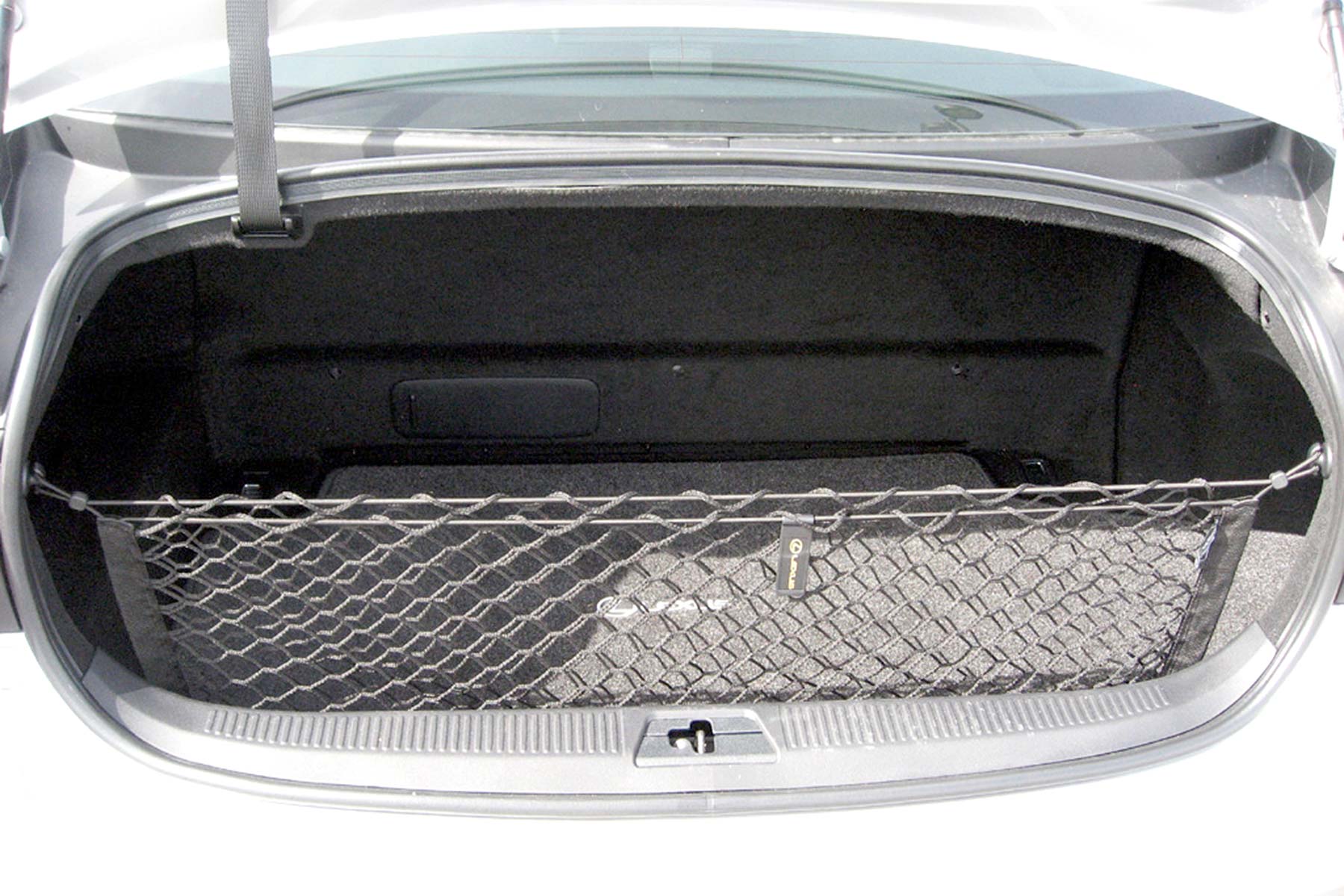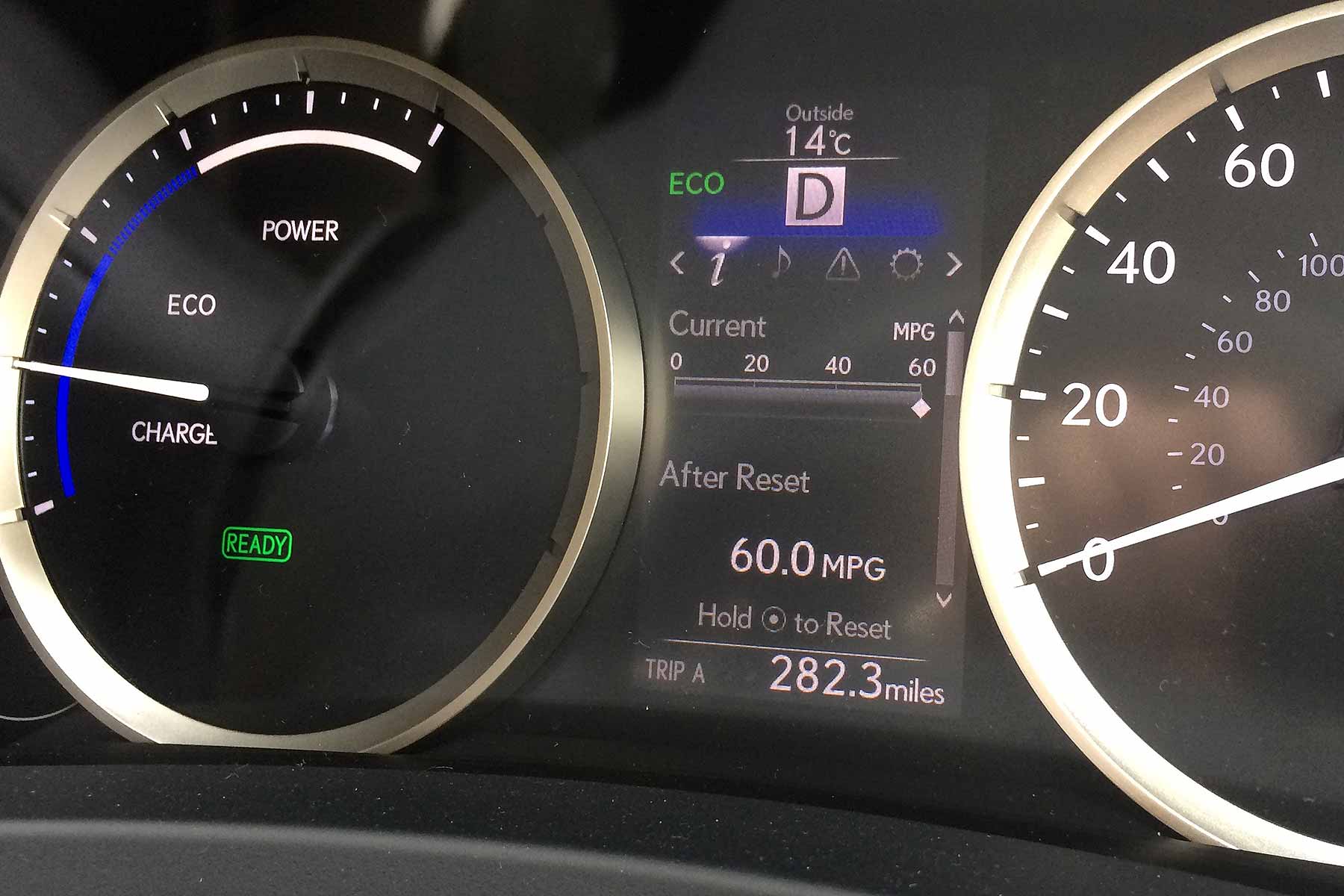 Lexus IS 300h long-term review: month 5
Lexus IS 300h long-term review: month 5
They said it couldn’t be done. 60mpg in a Lexus IS 300h? Nah mate, you need a diesel for that. Official figures might say you can get 60-plus, but we all know hybrids can’t do that in reality, don’t we?
I proved them wrong. And this wasn’t some sort of teeth-pulling economy drive, either. Simply a Saturday pootle with the family on board – and I only belatedly realised how good the economy was looking as I scrolled back through the trip computer.
One meek mooch through town later and I watched it appear before my eyes: 60mpg, clear as day. Proving my regular, easily achieved 55mpg during motorway commuting is far from a fluke.
So we’ve answered the big question once and for all. The Lexus IS 300h is green, is good on fuel, is improving with the summery weather. I was worried, before taking delivery, that I’d made an eco mistake and would, literally, pay for it. Not so – and the satisfaction of paying 5p a litre less for unleaded rather than diesel is, given such impressive economy, pleasing each and every time…
Hybrid holiday hit
Another worry I had was practicality. I’d switched from a Skoda Octavia vRS estate, one of the biggest family-sized cars on the planet. You could pile virtually anything into it, and last year’s summer holiday was done with space to spare.
Hybrids are far smaller though, aren’t they? Batteries eat into boot space and leave but tiny slots to load bags in, don’t they?
Again, not so. Quoted capacity is 450 litres and, although a few bags did stray into the rear cabin and front footwell, we still managed to pack a week’s worth of luggage, a travel cot, a pushchair, a bounty of food and even some spare bedding. It was absolutely loaded to the gunwhales, but it still all went in.
This is thanks to Lexus’ experience with hybrid: it designs cars specifically around it now, and it’s managed to squeeze and shape the batteries down to a size that leaves a boot comparable to a BMW 3 Series. Quite a contrast to early GS, as you can see…
Notebook
- Must remember to wait until the bleep after pressing the starter button before selecting drive. If you don’t, the hybrid systems get confused and tell you to shift back to P and try again.
- When is Lexus going to introduce electric parking brakes? The foot-operated lever feels so 1980s Mercedes-Benz with every press.
Lexus IS 300h long-term review: month 4
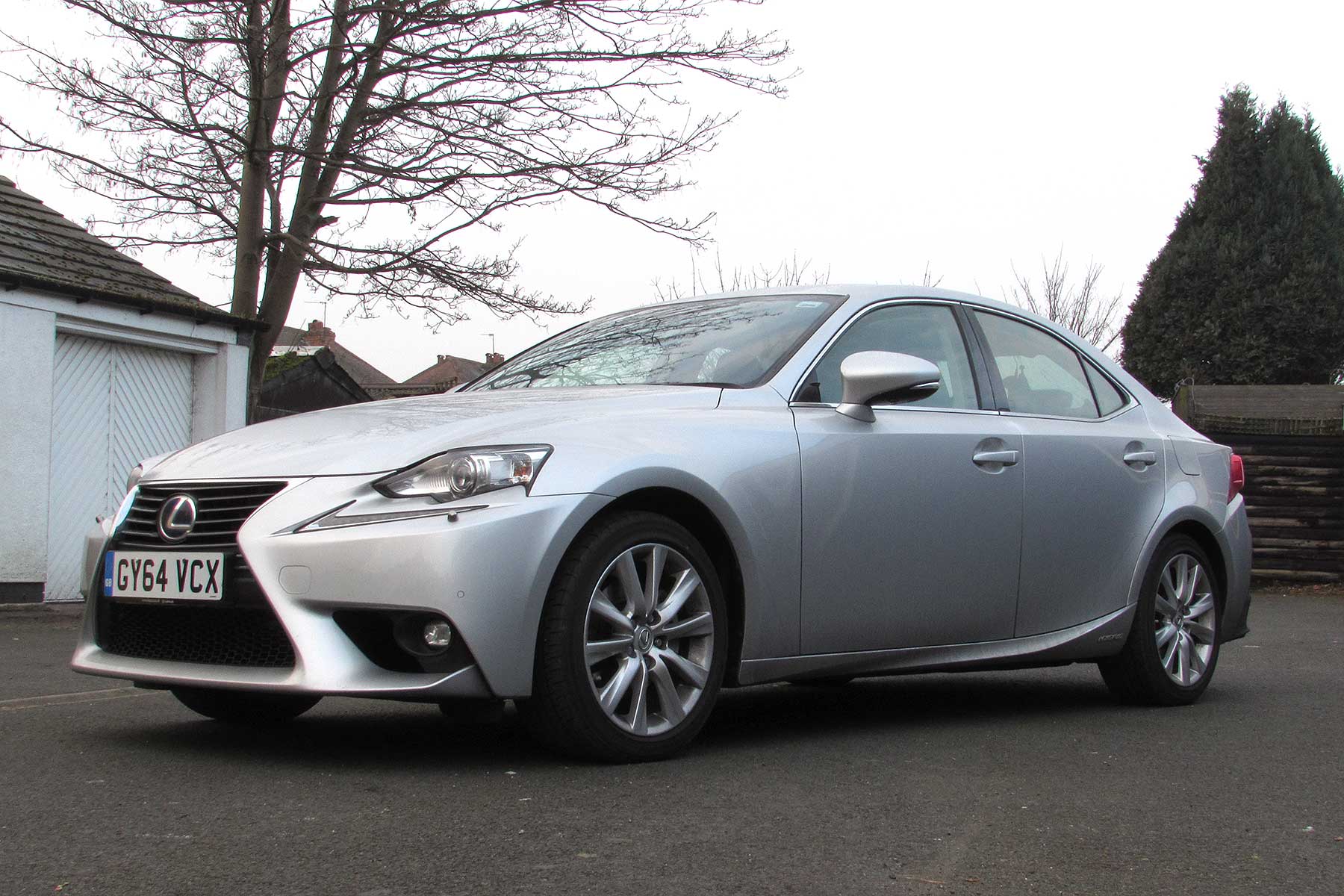
The weather’s warming up and the IS is coming into its own in two very welcome ways. One, the economy is getting even more impressive. And two, you can sit in traffic jams for a good 45mins with the air con chilling the cabin without needing to have the engine running.
Both points have had me enthusing about the Lexus this month. Mainly falls on deaf ears for those more interested in BMW 3 Series and Audi A4, mind – they’re waiting to see the new Jaguar XE, which I’m driving next week – but feedback from the Lexus Owners’ Club forum suggests there’s a strong and engaged Lexus core out there that joins me in liking this arguably undiscovered gem.
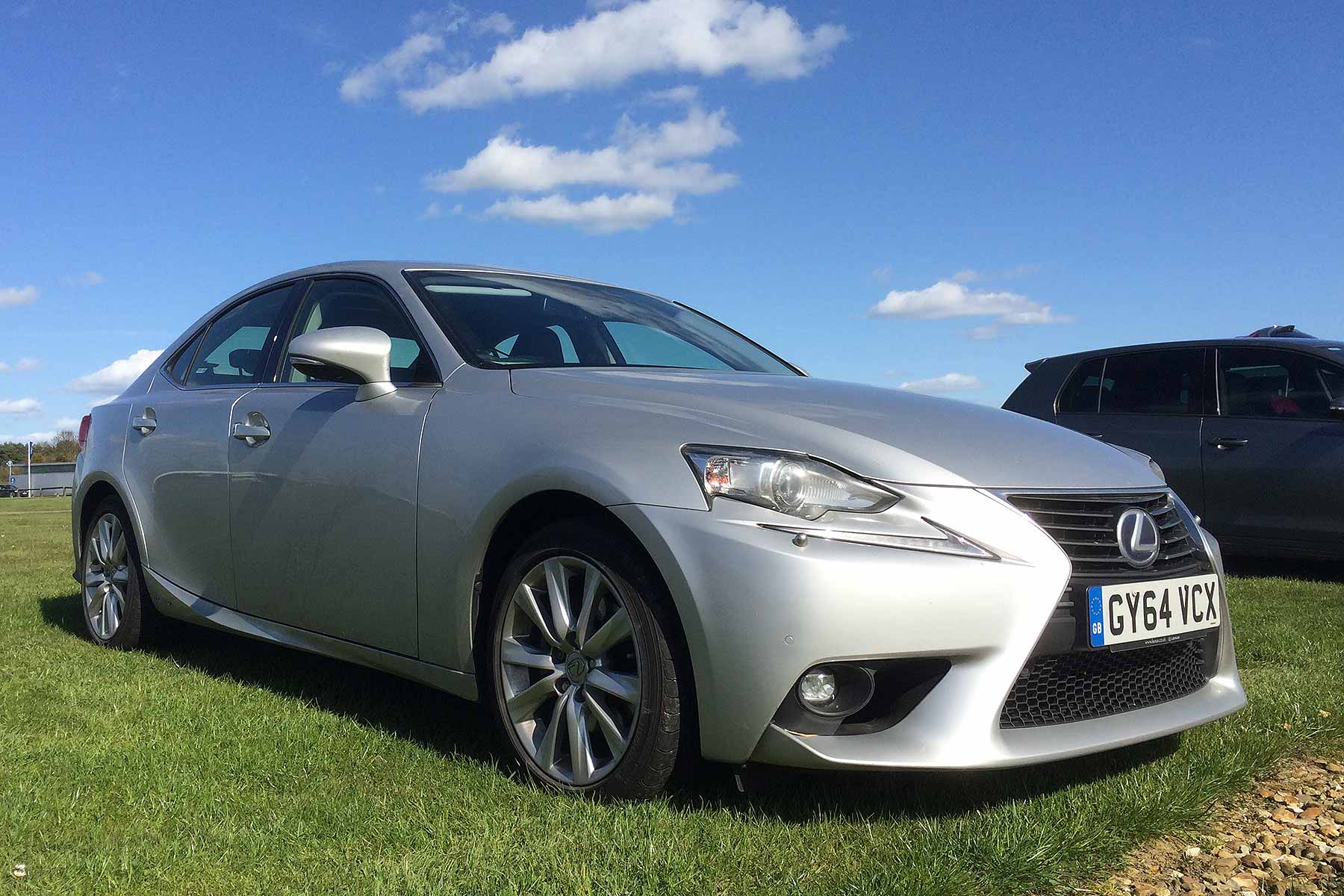
This month, I’ve finally proven it needs no fuel economy excuse for being petrol-electric hybrid instead of turbodiesel. Nearly 6,000 miles of driving has shown it to be uncannily similar to my old Skoda Octavia vRS in terms of mpg: namely, 55mpg on the run into work, around 50mpg during regular motorway use and, even if I’m pressing on, still a decent average of over 40mpg. If you drive it sensibly, you too should see high 40s and low 50s – without requiring any special techniques.
Some may question hybrid economy as only being good in town, but the IS 300h proves it’s able to perform out of town too. That question mark has thus been fully and comprehensively answered. Now, I’m looking forward to seeing how it improves with warmer weather.
Silverstone debut
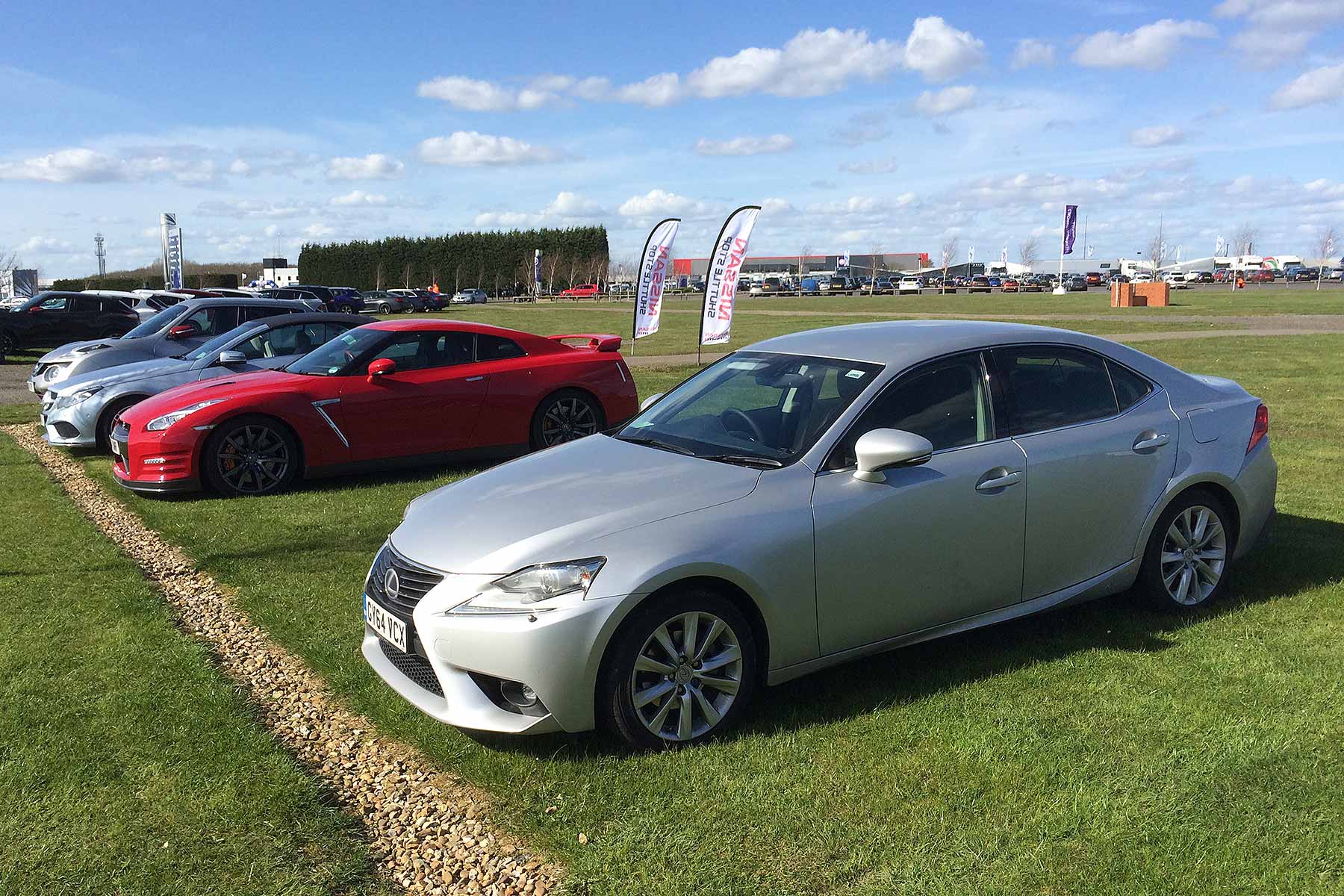
It was while enjoying this warm weather that I gave the Lexus its Silverstone debut, at the 2015 WEC Silverstone 6 Hours race event in early April. Quite fitting transport, given how high tech the racers are: the same hybrid branding that’s on the IS 300h’s door sills was boldly displayed on Toyota’s World Championship-winning WEC LMP1 racers.
I was there with Nissan (rival brand alert, etc), previewing its ambitious new Le Mans project. With a front-engine, front-wheel drive design, it’s like nothing else out there and, if the team realises its on-paper promise, could revolutionise Le Mans racing.
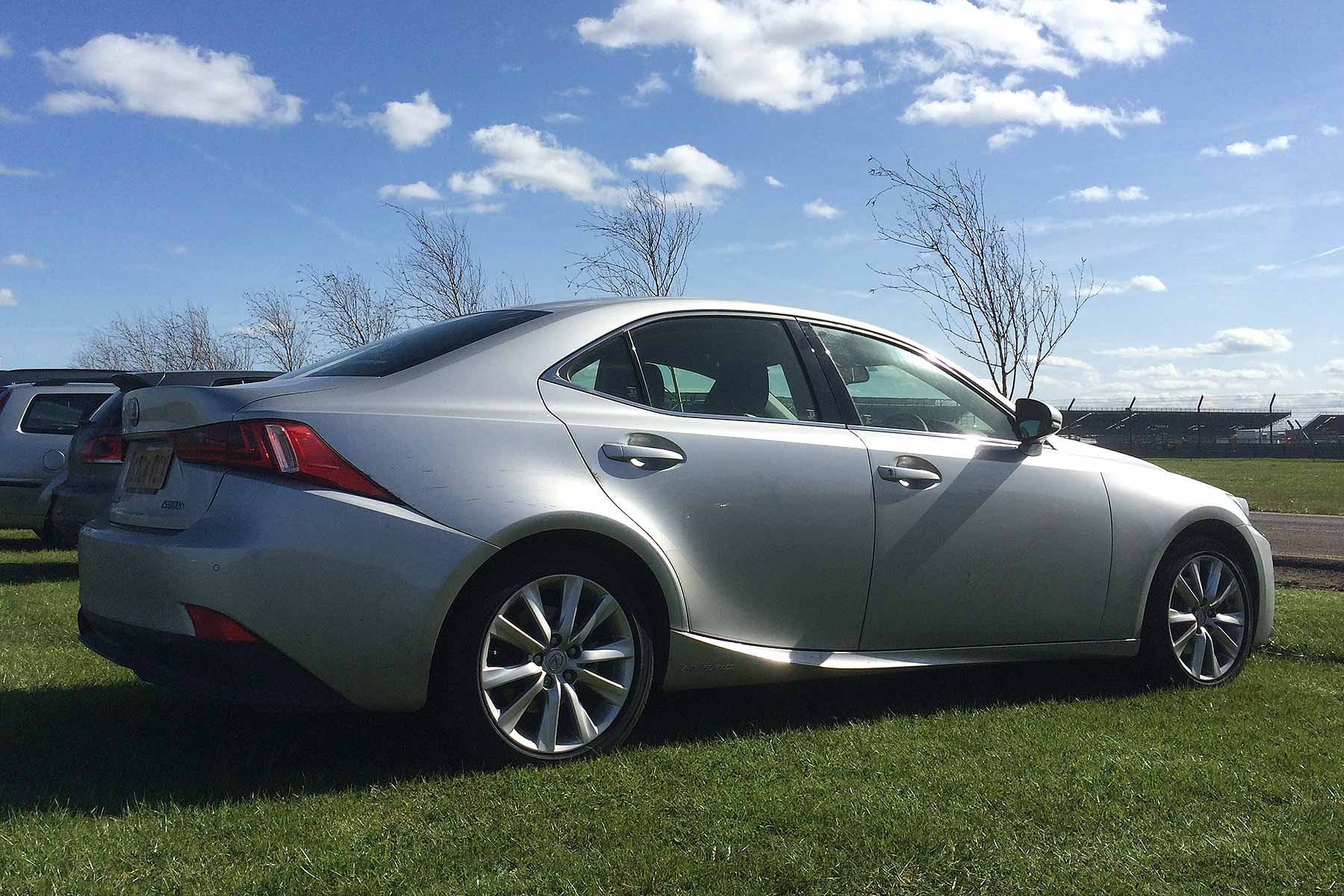
Lexus hasn’t quite done that with the IS but, sitting in traffic later on with the air con keeping me cool without the engine running (yet another example of what you can do with powerful on-board batteries), I did wonder why so few people see it as a 3 Series alternative. With the imminent new Jaguar XE, most consider a premium compact exec sector of three has swelled to four. Surely though, as the IS has been on sale for a few years now, it’s from four to five?
Maybe the upcoming group tests will give the feel-good IS the exposure it’s showing me it deserves…
Notebook
- Rain-repellent front side glass is a lovely feature. The windows magically stay clear of rain and, even cooler, it’s a really satisfying geeky detail to hand-wash: behold the difference in beading pattern!
- The stereo was oddly cutting in and out for a while, which I put down to poor DAB coverage. Nope: it’s because I had the sat nav on mute, and it seemed to be affecting the audio each time an instruction was issued. To investigate: for now, I’m simply enjoying the non-staccato playback
- When you put the gearbox in P, the doors unlock; when you move to D, they lock again. Brilliant feature that means I don’t have to scrabble for the door unlock button each time Mrs. A gets out and in. She appreciates this
- Something the Lexus has, that no other car I’ve driven has; a permanently-illuminated green light saying the parking sensor system is active. No need for the default bleep when you stick it in reverse, then – so long as you don’t forget you previously turned it off, that is. Guess it’s a ‘quiet revolution’ thing
Lexus IS 300h long-term review: month 3
Unlike Peter’s Audi A3 Sportback e-tron, nobody stops me in the street to ask how I’m getting on with my Lexus. That’s despite the petrol-electric setup being almost as clever (all it lacks is the extra plug-in capacity for the batteries). Just goes to show how far ahead of the rest Lexus was with its hybrid tech: today, it’s taken for granted.
Indeed, it now doesn’t bother to offer a turbodiesel alternative at all: bold move in a sector dominated by diesel, but one that pays off in a sector also dominated by CO2 emissions. Pick a base IS 300h and you enjoy sub-100g/km CO2 emissions, and even BMW’s ‘black magic’ EfficientDynamics tech can’t beat that. Indeed, it’s taken until 2015 and the imminent new Jaguar XE for a rival to even match it.
Trouble is, the base 99g/km CO2 car gets small wheels, and this is sector that doesn’t like small wheels. So the business-focused Executive model I’m running as a long-termer gets 17-inch alloys that look much more like it – and a corresponding 103g/km CO2 figure combined. Still good, just not quite as good as that ‘emissions from’ headliner car.
In reality, nobody cares. There are no fleet advantages to buying sub-100g/km cars anymore (road fund licence is so cheap for low emissions cars, the extra cost is minimal) and the bits included in the Executive more than outweigh any BIK savings.
For here, we have sat nav as standard. Leather seats as standard – heated ones at that. Front and rear parking sensors as standard (they’re a bit slow to respond, mind – remember this if you’re parking ‘swiftly’…). Xenon lights and Lexus ‘L’ daytime running LEDs as standard. DAB radio as standard. I can’t think of anything else I need as standard. Can you?
For £30k, it’s remarkably good value, something that was brought starkly to home recently when we have a Mercedes-Benz C 300 Bluetec Hybrid: list price, £38k. Price with options brining it largely into like with the Lexus, nearly £42k. Crumbs.
And, as our upcoming twin test will show, I know which I’d rather have.
Loving the Lexus
Me and the Lexus get on fine. I was worried what seeds I was sowing when I chose it over the de rigueur turbodiesel, but the reality is economy exactly the same as the Octavia vRS that went before it – without the TDI rattle, external clatter and need to use gloves when you fill it up. It just somehow feels… cleaner.
Partly, this is influenced by the current anti-diesel rhetoric, which is largely nonsense when applied to new cars. I wrote a few weeks ago about all the new diesels that are cleaner than a Fiesta Ecoboost petrol – come September, they’ll be mandatory and you can bet most other manufacturers are looking to get parity with petrol cars.
It’s the old diesels that’s the problem, and this is what the legislators are focusing on. Those that aren’t Euro 6 (or, at a push, Euro 5) are the smokey ones, the ones putting out lots of nasty NOx: driving a Lexus petrol-electric hybrid means I distance myself from such cars, and at the moment get to feel that bit more righteous at the pumps. Until the next bandwagon comes along, that is.
My experiment, I admit, was partly influenced by deadly diesel demonisation. But it was also through curiosity: we’d had hybrids on short-term test and always been slightly disappointed by them. This was, of course, because we were trying to drive a full lifecycle in a few weeks, so the real-world equalisation to economy could never take effect. Driving it day to day for six months lets things correct themselves.
That’s why I’m getting 55mpg in easy commuting use, and 45mpg when I’m in a rush to get to Goodwood, and that’s also why Mrs. A also gets 55mpg when she drives the kids around in it (I reset the trip and don’t tell her; I’m impressed).
The real advantage with a hybrid is the chance to really notch things up in situations where you may not be able to with a diesel – namely, in town. The punch of the electric motor (and reserve of the batteries) means that a half-gentle right foot is enough to set you away on electric-only power and cruise you to 30mph if there are no hills or obstacles in the way.
Electric clock shock
If I were Lexus, I’d fit a timer that resets on every journey, just to show people how often the engine is switched off: I’m sure it would surprise them, as the seemingly constant glow of the green ‘EV’ light in the left of the instrument pack is something I continually find reassuring.
Now the weather’s warming up, I can even get underway using electric power only. Given how I get up at 3 and leave the house by 4.30am, this is appreciated by me but praised deeply by my neighbours, particularly the light sleepers who like to leave their windows open at night (TDIs are gruff things when cold, I’ve been told…).
Not that it’s niggle free. Far from it. Just as the parking sensors are a bit slow, so too is the infotainment system. It’s like operating treacle. The rotary controller is half-intuitive like a BMW, but not fully, and you’re always aware of the grace a 3 Series’ controller displays alongside the clunky IS. Mrs. A finds it indecipherable, and sometimes, I’m with her.
Other small things: the self-centring indicators are nice, but if you indicate in the same direction in a BMW, they cancel. They don’t in a Lexus. Minor gripe but irritating half way through a roundabout. The slidey heater temperature controls are a bit fiddly, but so lovely-looking and different, I’ll forgive them. The foot-operating parking brake seems very 1980s when so many rivals have electric buttons. And couldn’t tyre noise be a little less than it is? Spoils the wonderful refinement of the hybrid drivetrain at speed, it does.
CVT shock win
What, you’re thinking: is that is? No mention of the CVT gearbox? Well, no. That’s because, in daily use, it makes huge sense. I’m enjoying its linearity, enjoying driving with its seamless elasticity, even enjoying the fact it holds onto high revs when I want high-rev power, rather than fiddling around with gearchange that try to chase an ideal power peak.
You may think I’ve taken leave of my senses, but this is a perfect example of why a few days being the wheel of a car don’t give a fulsome representation of what it’s actually like. As I’ve commented on previously, motorway cruises can see barely 1,500rpm registering, which is eco-friendly and remarkable given the fact this is a revvy petrol engine. Yet, soon as you need more shove, the revs dial up and it’s there, lag-free and supported by a torque-laden electric backdrop. It makes huge sense, particularly when you get into my habit of pre-empting sporty driving and switching to geared-up sport mode – the effervescence it adds to the drivetrain is uncommonly satisfying.
By way of contrast, that Merc had a seven-speed automatic gearbox, and felt ‘odd’ to me from the off. It seemed as if it couldn’t find the right gear, was flaring revs and bogging down, seemed notably less perfect and ideal than the Lexus’ one-gear, constantly-varying gearbox. Maybe this is a sign of the aged Merc’s 7G-TRIONIC imperfections; maybe it’s just me ‘getting’ CVT after a decade.
Or maybe it’s Lexus’ engineering helping me like something I’ve loathed in previous incarnations. Whatever, it’s all coming together quite nicely and, while the IS still isn’t the driver’s car a BMW 3 Series is (nor, for that matter, the new Jag XE…), it does still have enough distinct qualities and depth of abilities to make it worthy of spending time with.
Notebook
• What an elegant climate control system the Lexus has; it makes other cars seem a bit more route one. I sometimes don’t even realise I need a subtle refresh of cold air until it delivers it, and it’s the most set and forget system I’ve had on a long-termer.
• Those who remember old Lexus hybrids’ sorely compromised boots, at ease. Modern battery tech means the IS has 450 litres’ space, which is just 30 shy of a 3 Series. It’s commodious to take this family of four on holiday for a week, just (although the children did get a few bags between their seats and beneath their feet for company)
• For research purposes, I drove the 370 miles to Goodwood and back as quickly as sensibly possible one weekend. Economy average? 40mpg. Which, given my enthusiasm to get there (and get back for lunch with the family), I think is more than a little impressive. Yes, even when monstering it, I haven’t dipped into the 30s. Yet
• The cabin is as beautiful at night as it is at day. It’s a treat, those first few metres when pulling away at 4am, looking at the lovely ice-white lighting and glowing buttons. Quite the expert control deck, it is
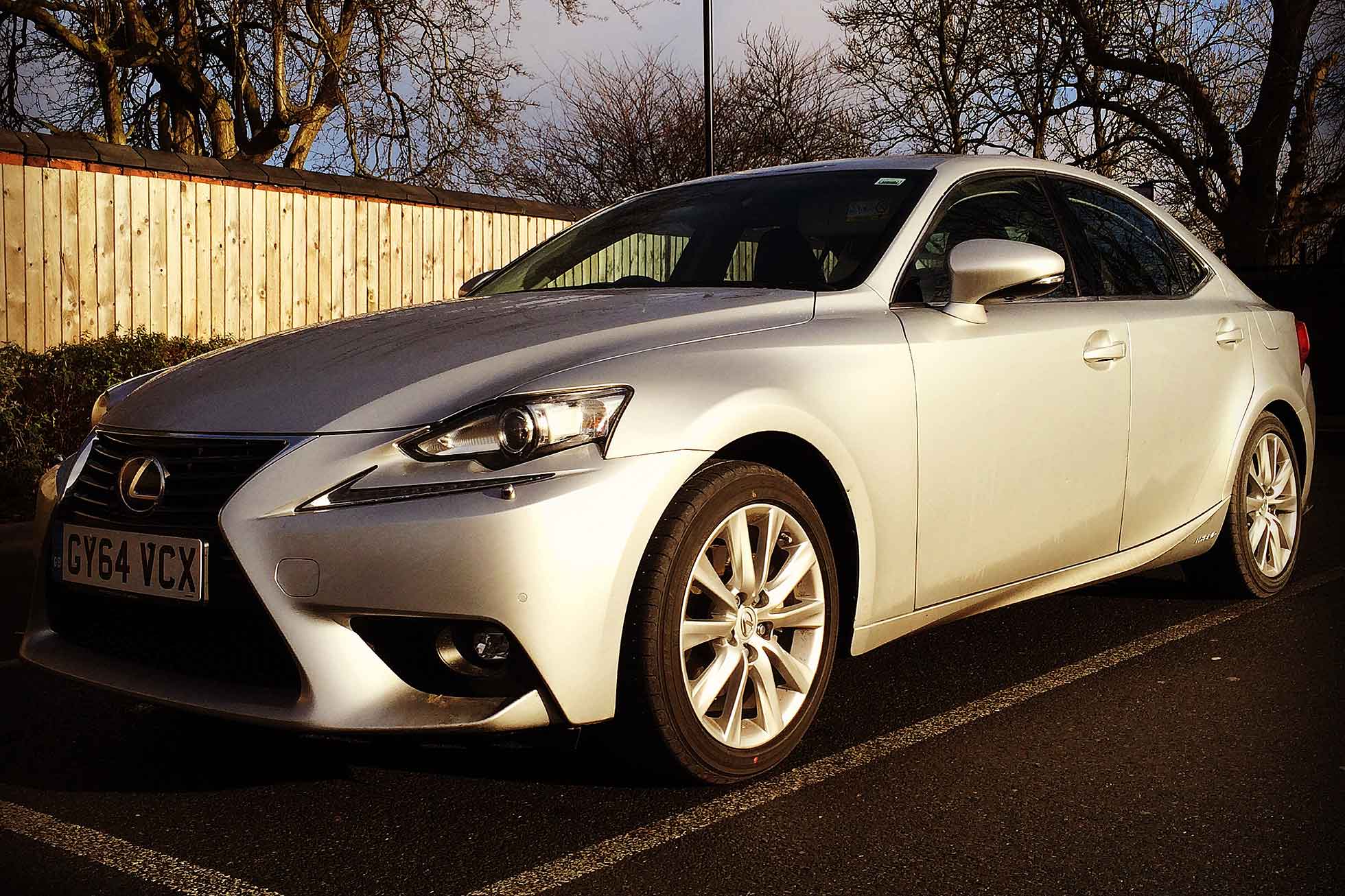 Lexus IS 300h long-term review month 2: the fuel economy crunch test
Lexus IS 300h long-term review month 2: the fuel economy crunch test
The first question most people have when I tell them I’ve switched from diesel to petrol hybrid: what economy are you getting?
With diesel, there’s an assumption that cars will deliver strong mileage, even if the reality isn’t quite there. But with hybrid, it’s split. Some believe a Toyota Prius will deliver 60mpg day in and day out, even if it’s driven at 90mph inches from the rear bumper of a BMW 320d (a surprising number are).
But others are more cynical, believing that hybrid cars are test cycle stars that don’t deliver anything like that in the real world. So, which is it? Cue my regular 100-mile-each-way commute to work (TM), a standard test that allows me to directly compare almost every car I’ve had in on test since 2001.
The Lexus started off… um, pretty middling. The first few runs, the factory-fresh engine was averaging mid-40s mpg. Good for a 223hp petrol car that does 0-62mph in 8.4 seconds; not so good compared to the +10mph of my old diesel Skoda Octavia vRS.
But then a funny thing happened. The mileage clicked over 1,000, I stated to be a bit less circumspect in my running-in-minded control of the hybrid’s revs… and mpg started to go up. We broke a 50mpg average. Then, low 50s. And now? An even 55mpg on the motorway-laden run into work is easily achieved.
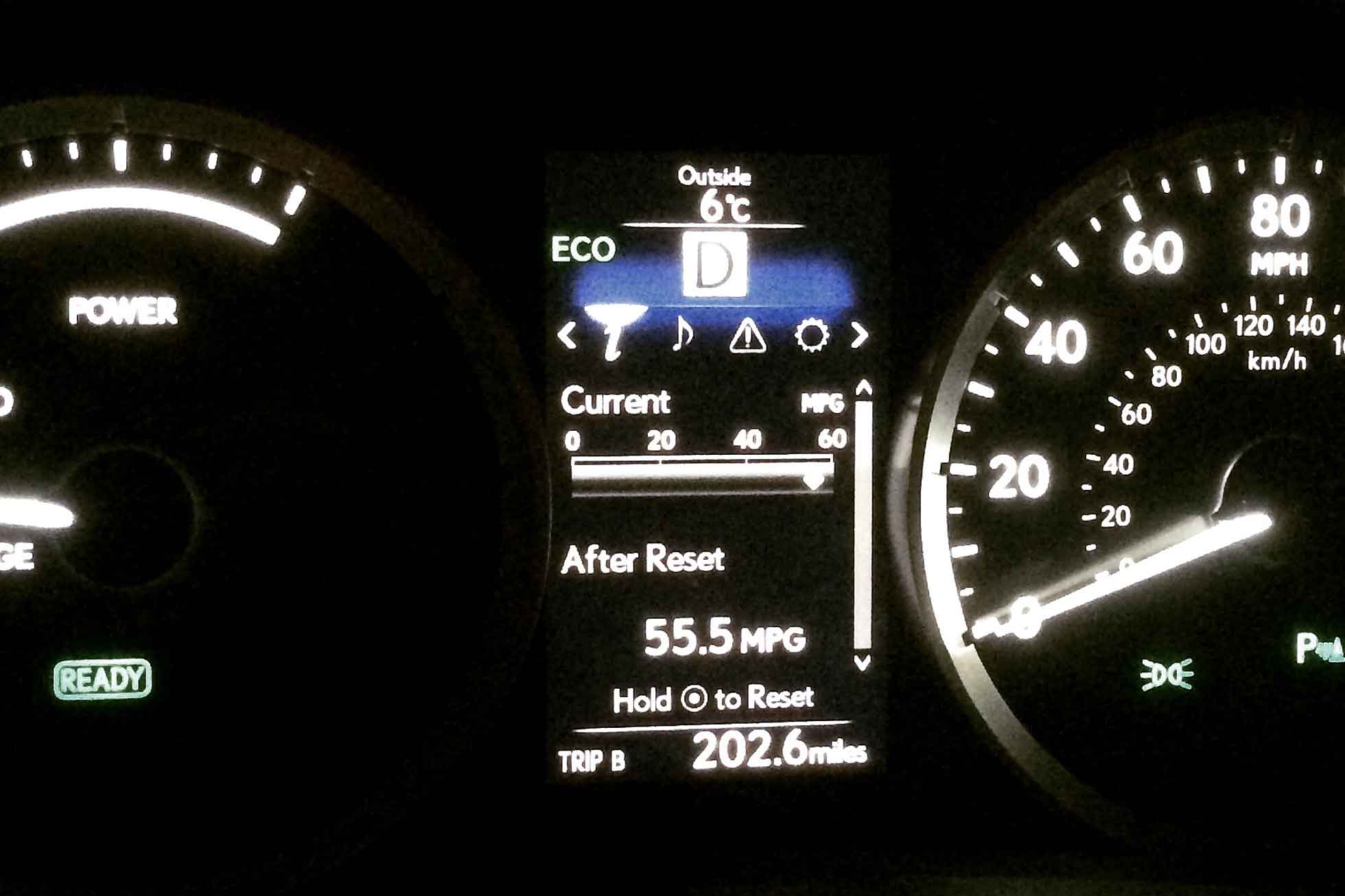
I’m a traditionalist. I like to take things gentle in cars for the first few miles, even though most say you don’t need to run modern cars in any more. Looks like the Lexus’ improving economy is proof of that. It also shows that, maybe, there is real-world logic in hybrid tech, too: see, that 55mpg commuting economy has already pretty much matched the vRS – and that’s before you factor in the price savings of petrol versus diesel…
Happy hybrid
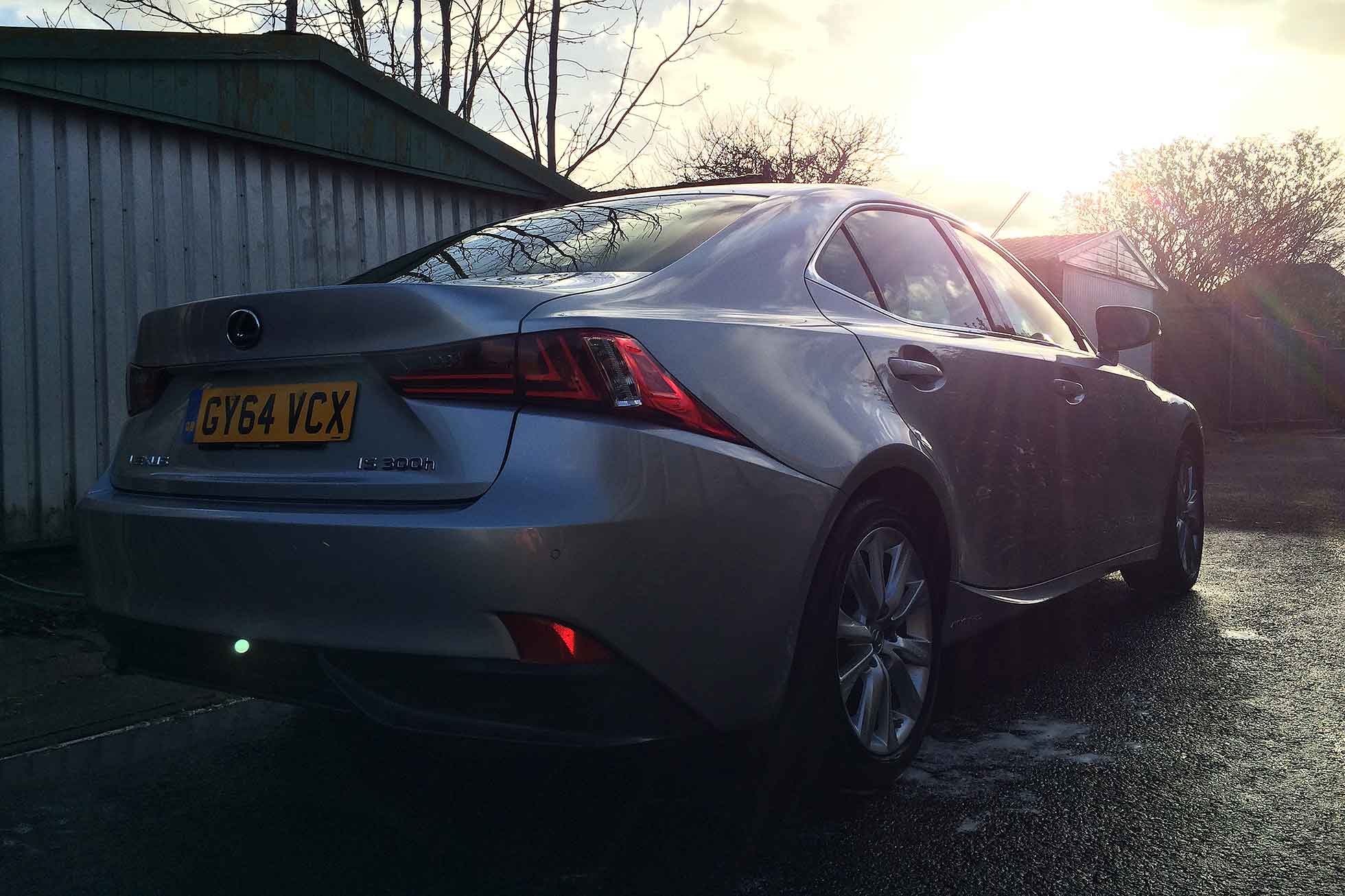
Obsession with economy over: the rest of the IS 300h is fairing quite nicely. Certainly the interior quality is a constant delight. I reckon no junior exec is more special inside than this – not even the new Jaguar XE, that I had chance to drive recently. Soft leather, tactile plastics, tremendous solidity: the Lexus cabin aces all comers.
I’m getting into the swing of hybrid driving as well. You don’t really have to do anything different if you don’t want to, but a bit of adaptation can use the tech to your advantage.
For example, pulling away: it does so under electric, and will reach 30mph with the engine off if you’re steady. As the motor responds smartly and strongly, I’ve started feeding the accelerator in gently when moving off, to avoid the engine immediately flaring and, I sense, benefitting from the electric motor doing the heavy lifting of getting the car rolling without wasting fuel.
Slowing down is satisfying too, because so long as you’re below 50mph, the engine will switch off until you need it again. Cruising through traffic on the motorway is thus a little more satisfying as, again, gentle use of the accelerator can keep the green ‘EV’ light glowing for a satisfyingly long time.
What the Lexus doesn’t do is show the chassis finesse of the new baby Jag. Nor the BMW 3 Series. Compared to those brilliant two rivals, the ride is lumpier, steering more distant, handling less incisive. It’s OK, with sporty initial crispness to make it feel quite lively, but doesn’t have the expertise of its two key rivals.
Really, though, I’m not testing the chassis. I’m seeing if hybrid can be a genuine alternative to diesel in this diesel-dominated sector. And, right now, I’m happy.
Notebook
- Few things are more satisfying than pulling the doorhandle of the IS, or feeling the soft leather steering wheel, or adjusting the stereo volume using the Japanese hi-fi-style knob. Tactile attention to detail is superb.
Lexus IS 300h long-term review: introduction
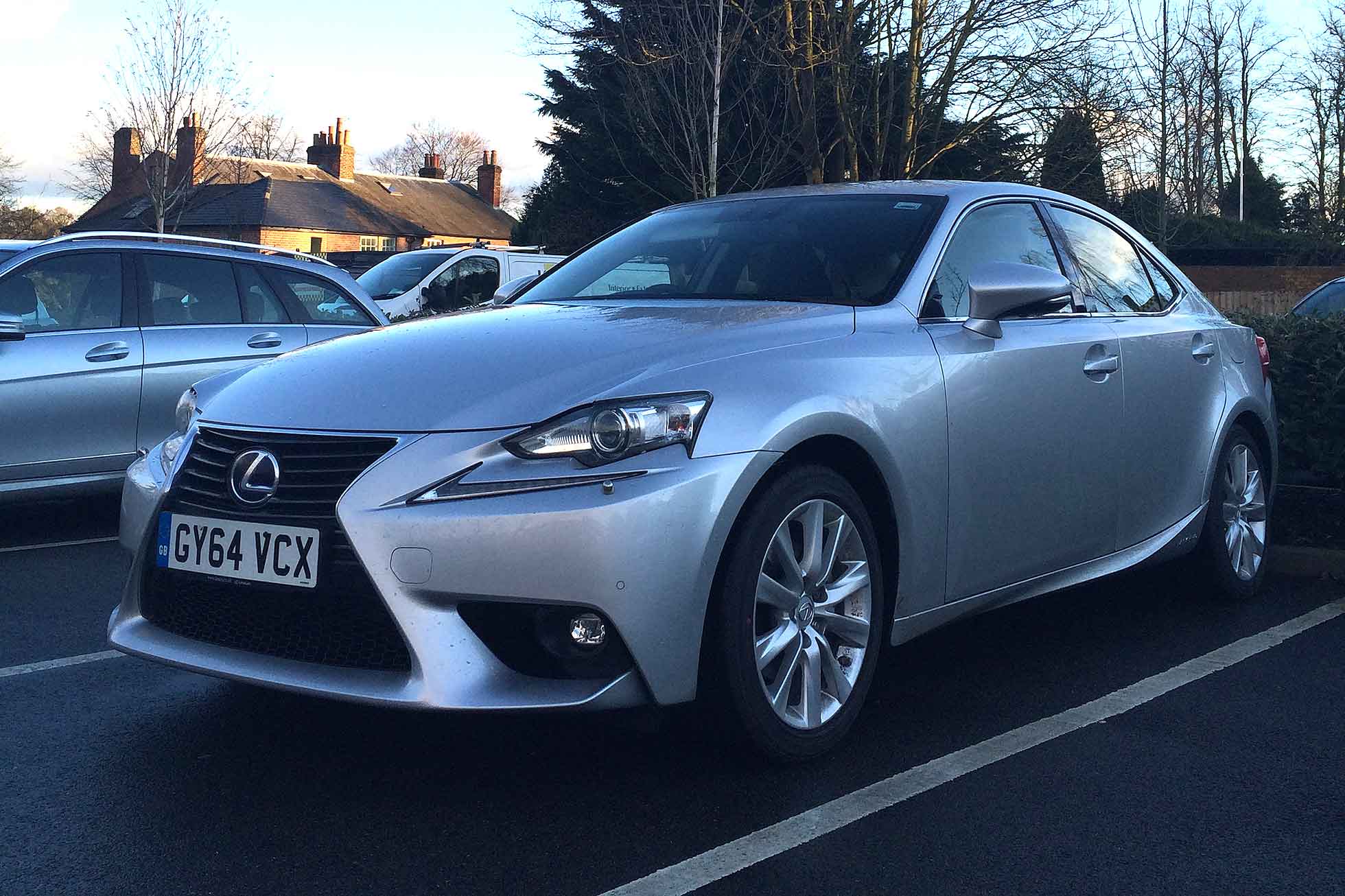
Boris Johnson. Islington Council. France. The EU. Diesel is facing attacks from all quarters at the moment, and all because some claim it’s not quite as green and clean as we have been led to believe.
Diesel is great for reducing CO2, and the switch to diesel is a major factor behind Britain’s new cars emitting far less of the greenhouse gas than they were even just five years ago. One of the greenest things you can do is simply swap a decade-old car for a brand new one – and as CO2 relates directly to fuel consumption, you’ll enjoy a healthy saving at the pumps too.
Trouble is, diesels emit higher levels of some other pollutants, including NOx. And it is an excess of NOx that causes inner-city smog on hot sunny days (it’s been linked to other respiratory diseases too). Exceeding limits on NOx, along with particulates, is what the European Union is all set to fine us big for.
It’s not that simple, of course. Brand new diesel cars are not the problem. Indeed, buy one of the latest Euro 6 diesels and you’ll have a car that pretty much matches a petrol car for tailpipe emissions – including NOx. It’s older diesel cars, and HGVs, and buses, and taxis, that are the problem. ‘All diesel cars’ are simply getting rounded up and scowled at by umpteen naysayers.
I love diesel. I love its torque, its range, the fact even small diesels feel like much bigger ones. Every long-termer I’ve ever had has been powered by diesel. But the current furore has got me thinking. Is there really an alternative to diesel for the person driving upwards of 30,000 miles a year?
Hybrid: the alternative to diesel?
Enter Lexus. To the befuddlement of many for years, it’s steadfastly eschewed diesel in favour of petrol-electric hybrid. There’s a hybrid version of every Lexus on sale; usually, it’s the best selling version in the range. Lexus matches its rivals for claimed fuel economy, and CO2, and tax-friendliness, without straying near the black pump.
The current best-seller? The compact executive IS 300h, which goes up, against the BMW 3 Series, Audi A4 and Mercedes-Benz C-Class and which, until the reveal of the Jaguar XE, has been the only genuine alternative to the dominant German brands (sorry, Infiniti).
(Comparisons with the XE and the other compact execs were another reason for picking it, I admit. It’s going to be a five-way battle and I wanted to get to know the outsider as well as I’m getting to know the upstart Jag…)
I’m thus now a custodian of one for six months. An IS 300h Executive, the best-selling variant whose bountiful standard specification includes sat nav, heated leather seats, Xenon headlights and a feast of electric buttons. All for £29,995 (plus £610 for metallic – the only option we’ve had fitted), whose appeal swells further to tax-conscious company car driver through CO2 of just 103g/km and no 3% diesel surcharge to factor in.
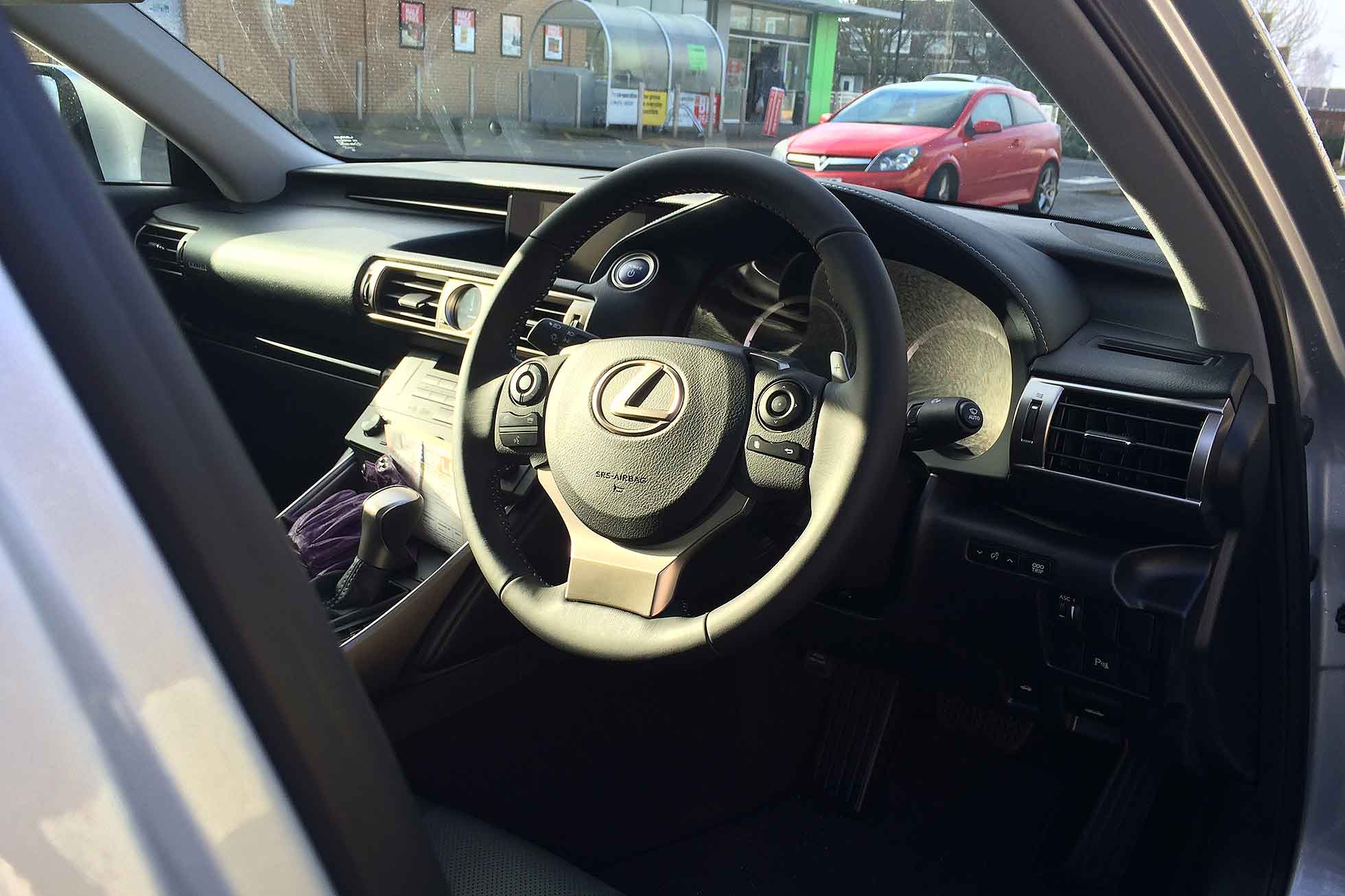
It’s a bargain and yet, stepping into it for the first time, you’d swear it cost £5,000 more. Japanese factory-fresh with just 187 miles on the clock, my Sonic Titanium (cool name) was flooded with showroom appeal; so-soft leather steering wheel, firm and low-set seats, centre console that looks as premium as a Japanese hi-fi. You know when you’re in a lower-end 3 Series. Not here.
Then there’s starting it up for the first time. Press the button: it bleeps. That’s it. No diesel shudder, no faint tickover rumble. Hybrid means pull-away and slower-speed gentle-throttle driving is done under instant-response electric power, smoother than the greatest V12. The four-cylinder petrol eventually kicks in but, by then, you’re rolling and moving and so barely even notice it.
As I dropped the delivery driver off at the train station, it was a comprehensive thumbs-up for my first drive. First impressions of my diesel sojourn hadn’t revealed any nasty surprises or confirmed any worries. Now to find out what it’s really like to, for the first time in a decade, consistently reach for the green pump…
Notebook
- The first motorway trip had me worried: it was low-40s mpg. Since then, however, it’s improving…
- Firm seats felt a bit too firm at first. I’m either getting used to them or they’re wearing in; no such complaints now
- Was upset by the lack of a rev counter – until I discovered that switching to Sport mode changes the ‘chargeometer’ into a proper tacho. This revealed…
- … 70mph could see it pulling less than 1,400rpm if you took it steady! With tricks like this, I could yet come round to the idea of CVT
Specification: 2015 Lexus IS 300h Executive Edition
Price (January 2015): £29,995
Price with options: £30,605 (metallic paint £610)
Engine: 2.5-litre four-cylinder petrol-electric hybrid
Power: 184hp (system total: 223hp)
Torque: 221lb ft
0-62mph: 8.4 secs
Top speed: 125mph
MPG: 64.2
CO2: 103g/km


